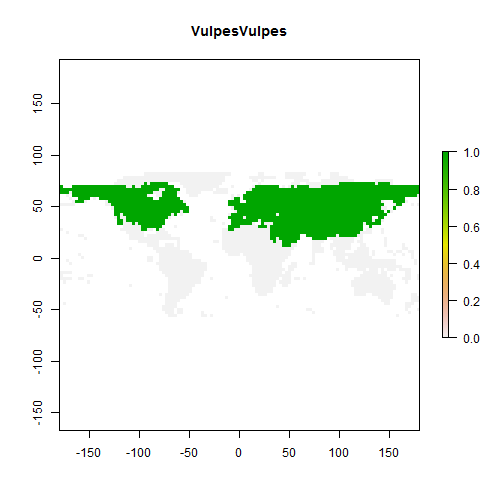Creating a presence-absence raster from point data
Want to share your content on R-bloggers? click here if you have a blog, or here if you don't.
I’m working on generating species distribution models at the moment for a few hundred species. Which means that I’m trying to automate as many steps as possible in R to avoid having to click buttons hundreds of times in ArcView.
One of the tasks that I need to do is to convert presence-only latitude and longitude data into a presence-absence raster for each species. It seems like this would be something that relatively simple but it took me longer than it should have to figure it out. So I’m posting my code here so 1) I don’t forget how I did it; and 2) because I had someone ask me how to exactly this thing this afternoon and it took me ages to hunt through my poorly organised files to find this piece of code! So here it is:
Because I’m a function kinda girl, I wrote this as a function. It basically goes through three steps:
1. Take an existing raster of the area you are interested in mask.raster and set the background cells to zero (absences).
2. rasterize the presence points for your species species.data and set those cells to one (presences).
3. Label the new raster by your species names raster.label and save it as a new raster.
presence.absence.raster <- function (mask.raster,species.data,raster.label="") {
require(raster)
# set the background cells in the raster to 0
mask.raster[!is.na(mask.raster)] <- 0
#set the cells that contain points to 1
speciesRaster <- rasterize(species.data,mask.raster,field=1)
speciesRaster <- merge(speciesRaster,mask.raster)
#label the raster
names(speciesRaster) <- raster.label
return(speciesRaster)
}
Below is an example of how the function works using data on the global distribution of foxes data from the biomod2 package.
library(biomod2)
# read in species point data and extract data for foxes
mySpecies <- read.csv(system.file("external/species/mammals_table.csv", package="biomod2"), row.names = 1)
species <- "VulpesVulpes"
# extract fox data from larger dataset and keep only the x and y coordinates
fox.data <- mySpecies[,c("X_WGS84", "Y_WGS84",species)]
fox.data <- fox.data[fox.data$VulpesVulpes==1,c("X_WGS84", "Y_WGS84")]
# read in a raster of the world
myRaster <- raster(system.file( "external/bioclim/current/bio3.grd",package="biomod2"))
# create presence absence raster for foxes
pa.raster <- presence.absence.raster(mask.raster=myRaster, species.data=fox.data, raster.label=species)
plot(pa.raster, main=names(pa.raster))
In this plot, the presences (1) are shown in green and the absences (0) in light grey.
Helpful things to remember (or things I learnt the hard way)
- Make sure your species point data and raster are in the same projection and that they actually overlap!
- Set your desired raster extent and resolution in the
mask.rasterbefore you get started. - The species point data that you feed into the function should just be a list of x and y co-ordinates – no species names or abundances or you’ll confuse the poor beast and it won’t work!
And yes, foxes are also present in Australia where they are a pest. I guess this map shows their natural range before people started doing silly things.
Bought to you by the powers of knitr & RWordpress
(Well it was and then things went a little awry, so I had to do some tinkering!)
R-bloggers.com offers daily e-mail updates about R news and tutorials about learning R and many other topics. Click here if you're looking to post or find an R/data-science job.
Want to share your content on R-bloggers? click here if you have a blog, or here if you don't.

